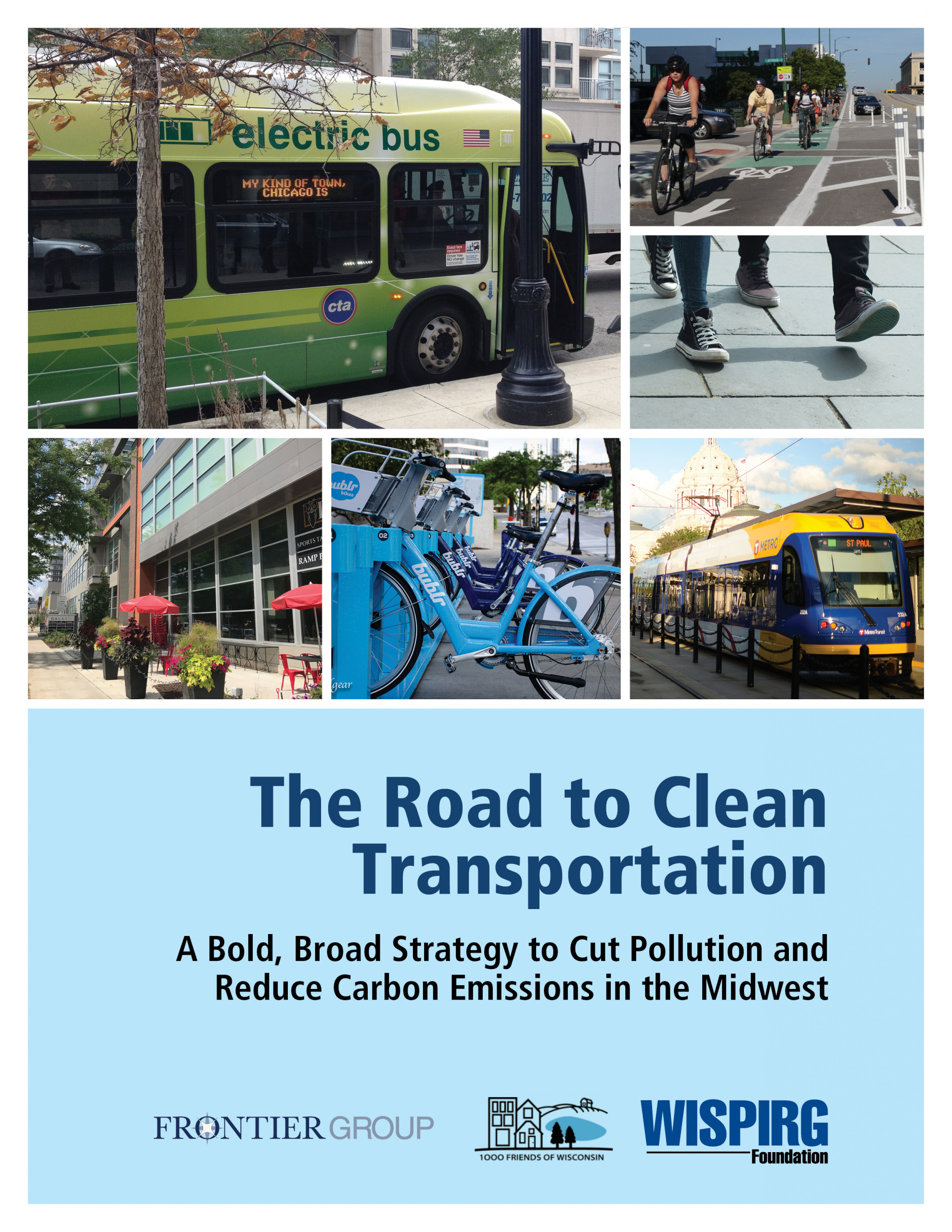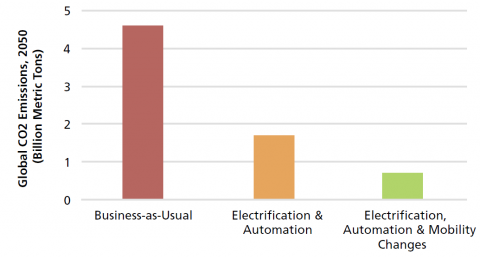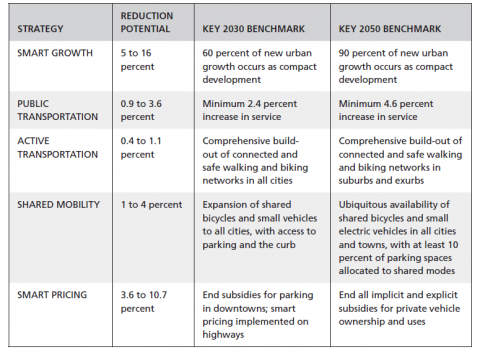The Road to Clean Transportation
A Bold, Broad Strategy to Cut Pollution and Reduce Carbon Emissions in the Midwest
By transforming our vehicles, rethinking the design of our cities and towns, maximizing the benefits of new technologies, and doubling down on proven strategies like public transit, the Midwest can ensure that the transportation system we pass on to our children is clean, resilient, equitable and accessible to all.

EXECUTIVE SUMMARY
Transportation is central to daily life in the Midwest and to our economy. But the effects of our transportation system extend far beyond the time we spend commuting or the ability of a company to receive freight on time. Our transportation system shapes how our communities look and feel, the opportunities for advancement and growth that are available to our people, and the quality of the air we breathe.
The Midwest’s transportation system is also reshaping our climate. Transportation is now responsible for nearly one-third of the region’s carbon dioxide emissions.[i] Our dependence on fossil fuel-powered vehicles, and the vast number of miles we travel in those vehicles every year, contributes to global warming, which, in turn, threatens the Midwest with more extreme weather – everything from higher temperatures to more intense downpours – in the years and decades to come.
But a better future is possible.
By transforming our vehicles, rethinking the design of our cities and towns, maximizing the benefits of new technologies, and doubling down on proven strategies like public transit, the Midwest can ensure that the transportation system we pass on to our children is clean, resilient, equitable and accessible to all.
Studies by leading academics, national laboratories and nonprofit groups have envisioned what a transformed transportation system might look like – and the role it might play in combating global warming. For example, a 2017 study from researchers at the University of California, Davis, and the Institute for Transportation & Development Policy found that by shifting mobility patterns through the expansion of things like public transit, walking, and biking, along with electrifying and automating vehicles, global emissions would be a fraction of a business-as-usual scenario (see Figure ES-1).[ii]
Figure ES-1. Global Emissions Resulting from Three Scenarios in 2050[iii]

A complete strategy for decarbonizing transportation that reduces the need for driving can complement efforts to power vehicles with clean energy, and can be more effective, more resilient, and create a more equitable transportation system than strategies that rely only on changes to vehicles and fuels.
The Midwest can start bringing a future of equitable, accessible zero-carbon mobility closer to reality today, by embracing proven and emerging tools to expand low-carbon transportation choices, and by setting bold goals and benchmarks for the future. In the Midwest, smart transportation and smart growth strategies could reduce transportation energy demand and lead to emissions reductions of at least 20 percent by 2050, with greater reductions possible if those strategies are adopted together.
Key strategies include:
- Smart Growth and Compact Development: Emissions Reduction Potential – 5 to 16 percent by 2050[iv]
Sprawling, single-use developments necessitate traveling longer distances and often require the use of private vehicles. Cities and towns that prioritize compact mixed-use development bring destinations closer together, reducing the need for travel and enabling the use of a wide variety of low- and zero-carbon transportation options. In the Twin Cities area, for instance, shifts in development patterns led to a two-thirds reduction in the land area required per new resident between 2000 and 2016 compared with the decade prior, a change that can greatly reduce transportation demand.[v]
- Public Transportation: Emissions Reduction Potential – 0.9 to 3.6 percent by 2050[vi]
Public transit helps reduce emissions from transportation in several ways: moving large numbers of people efficiently, supporting electrification of transportation, and supporting compact development. Residents of transit-rich communities drive 10 to 30 percent fewer miles than residents of car-oriented neighborhoods; expanding transit can reduce emissions while increasing mobility opportunities for people underserved by a car-centered transportation system.[vii]
- Active Transportation: Emissions Reduction Potential – 0.4 to 1.1 percent by 2050[viii]
Walking and biking are zero-carbon modes of transportation that can substitute for motorized transportation while improving public health. Cities that provide safe, accessible infrastructure and pedestrian-scale land uses already see high rates of walking and biking – in Madison, more than 13 percent of commuters walk or bike to work; in Minneapolis, nearly 11 percent of people walk or bike to work; in Chicago, more than 8 percent do.[ix]
- Shared Mobility: Emissions Reduction Potential – 1 to 4 percent[x]
Shared transportation options, including carsharing and bikesharing, enable more people to travel without owning a personal car and can help reduce total vehicle miles traveled. Shared fleets of vehicles may also help speed the electrification of transportation. In a 2016 study, carsharing participants drove an average of 11 percent fewer miles, reducing their greenhouse gas emissions by an average of 10 percent.[xi]
- Smart Pricing: Emissions Reduction Potential – 3.6 to 10.7 percent by 2050[xii]
In the Midwest and across America, high-carbon modes of transportation are subsidized through public policy, while opportunities to manage congestion through the use of pricing are missed. Ending those subsidies and ensuring that Midwesterners pay the full cost of their travel (including the environmental and societal costs of car use) would encourage the use of lower-carbon modes of travel and support the Midwest’s ability to reduce carbon pollution.
Maximizing the potential of these strategies will require meeting benchmarks along the way, including:

Strategies to reduce vehicle travel and achieve significant emissions reductions can also improve societal equity. Access to robust, affordable and efficient transit systems can allow low-income families to live without a car, saving thousands of dollars a year on loan payments, gas, insurance and maintenance – freeing up funds for other priorities.[xiii] Expanded transportation options can connect people in marginalized communities to jobs and other opportunities that were previously unreachable without a car.
Transitioning to a low- or zero-carbon transportation system by mid-century will require immediate action and longer-term planning from all levels of government across a variety of sectors. With a bold vision and commitment to concrete steps, the Midwest will be more likely to achieve success in decarbonizing transportation at the pace necessary to prevent the worst impacts of climate change.
[i] National: U.S. Energy Information Administration, Monthly Energy Review, May 2018; States: U.S. Energy Information Administration, State Carbon Dioxide Emissions Data – 2015, 24 October 2017.
[ii] Lew Fulton and Dominque Meroux, UC Davis; Jacob Mason, ITDP, Three Revolutions in Urban Transportation, May 2017.
[iii] Graph recreated from estimates from a chart in the report; see report for all assumptions and findings. Ibid.
[iv] Emissions reductions compared to total emissions from light duty vehicle emissions, without considering emissions benefits from any other strategies. Emissions reductions range and deployment assumptions estimated from a review of multiple studies in U.S. Department of Transportation, Transportation’s Role in Reducing U.S. Greenhouse Gas Emissions – Volume 2, Land Use, Section 5-54,April 2010.
[v] Metropolitan Council, MetroStats – Growing Greener, Getting Leaner: Land Use in the Twin Cities Region, June 2017.
[vi] Emissions reductions compared to total emissions from light duty vehicle emissions, without considering emissions benefits from any other strategies. Emissions reductions range and deployment assumptions estimated from a review of multiple studies in U.S. Department of Transportation, Transportation’s Role in Reducing U.S. Greenhouse Gas Emissions – Volume 2, Transit Expansion, Promotion, Service Improvements, Section 5-34, April 2010.
[vii] Todd Litman and Rowan Steele, Victoria Transport Policy Institute, Land Use Impacts on Transport: How Land Use Factors Affect Travel Behavior, 11 April 2018.
[viii] Emissions reductions compared to total emissions from light duty vehicle emissions, without considering emissions benefits from any other complementary strategies. Emissions reductions range and deployment assumptions estimated from a review of multiple studies in U.S. Department of Transportation, Transportation’s Role in Reducing U.S. Greenhouse Gas Emissions – Volume 2, Nonmotorized Transport, Section 5-49, April 2010.
[ix] U.S. Census Bureau, 2016 American Community Survey 1-year Estimates, Means of Travel to Work – B08301, excluding people who work from home.
[x] Emissions estimate: Assuming a conservative estimate that 10 percent of people will participate in shared mobility (Susan Shaheen, Adam Cohen and J. Darius Roberts, “Carsharing in North America: Market Growth, Current Developments, and Future Potential,” Transportation Research Board 1986, July 2015; McKinsey & Company, Automotive Revolution – Perspective Towards 2030: How the Convergence of Disruptive Technology-Driven Trends Could Transform the Auto Industry, January 2016); and assuming that carsharing participants reduce their transportation emissions 10 – 40 percent (Elliott Martin and Susan Shaheen, Transportation Sustainability Research Center, The Impacts of Car2go on Vehicle Ownership, Modal Shift, Vehicle Miles Traveled, and Greenhouse Gas Emissions: An Analysis of Five North American Cities, July 2016)
[xi] Elliott Martin and Susan Shaheen, Transportation Sustainability Research Center, The Impacts of Car2go on Vehicle Ownership, Modal Shift, Vehicle Miles Traveled, and Greenhouse Gas Emissions: An Analysis of Five North American Cities, July 2016.
[xii] Emissions reductions compared to total emissions from light duty vehicle emissions, without considering emissions benefits from any other complementary strategies. Emissions reductions range and deployment assumptions estimated from a review of multiple studies in U.S. Department of Transportation, Transportation’s Role in Reducing U.S. Greenhouse Gas Emissions – Volume 2, Pricing, Section 5-2, April 2010.
[xiii] AAA, AAA Reveals True Cost of Vehicle Ownership (press release), 23 August 2017.